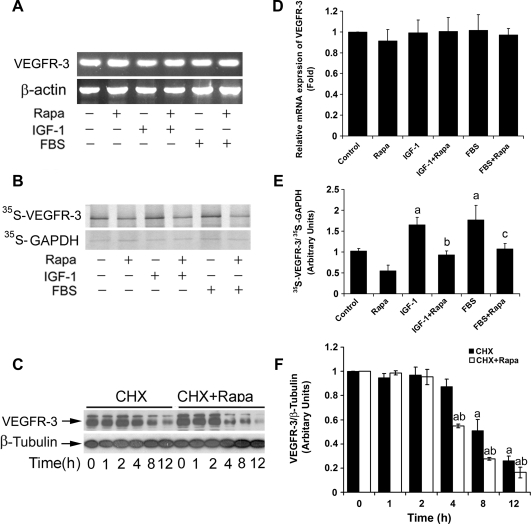Figure 6.
Rapamycin does not alter mRNA expression but inhibits protein synthesis and promotes protein degradation of VEGFR-3. (A) Rapamycin did not affect VEGFR-3 mRNA level. Total RNA was extracted from LECs treated with rapamycin (Rapa, 100 ng/ml) for 24 hours in the presence or absence of IGF-1 (10 ng/ml) or 2% FBS, followed by semiquantitative RT-PCR. β-Actin was used as a loading control. (B) Rapamycin inhibited protein synthesis of VEGFR-3 in LECs. LECs were pretreated with rapamycin (Rapa, 100 ng/ml) for 24 hours, in the presence or absence of IGF-1 (10 ng/ml) or 2% FBS, and then pulsed with 35S-Met/Cys for 4 hours, followed by immunoprecipitation with antibodies to VEGFR-3. The immunoprecipitates were separated by SDS-PAGE and transferred to polyvinylidene fluoride membranes, followed by autoradiography. GAPDH served as an internal control. (C) Rapamycin promoted protein degradation of VEGFR-3 in LECs. LECs, grown in 10% FBS-DMEM/F12 medium, were exposed to CHX (50 µg/ml), in the presence or absence of rapamycin (Rapa, 100 ng/ml) for 0 to 12 hours, followed by Western blot analysis with the indicated antibodies. Semiquantitative data for A, B, and C by densitometry using ImageJ are shown in D, E, and F, respectively. Results are means ± SD and are pooled from three independent experiments. aP < .05, difference versus control group. bP < .05, difference versus IGF-1 group. cP < .05, difference versus FBS group. dP < .05, difference versus CHX group.

